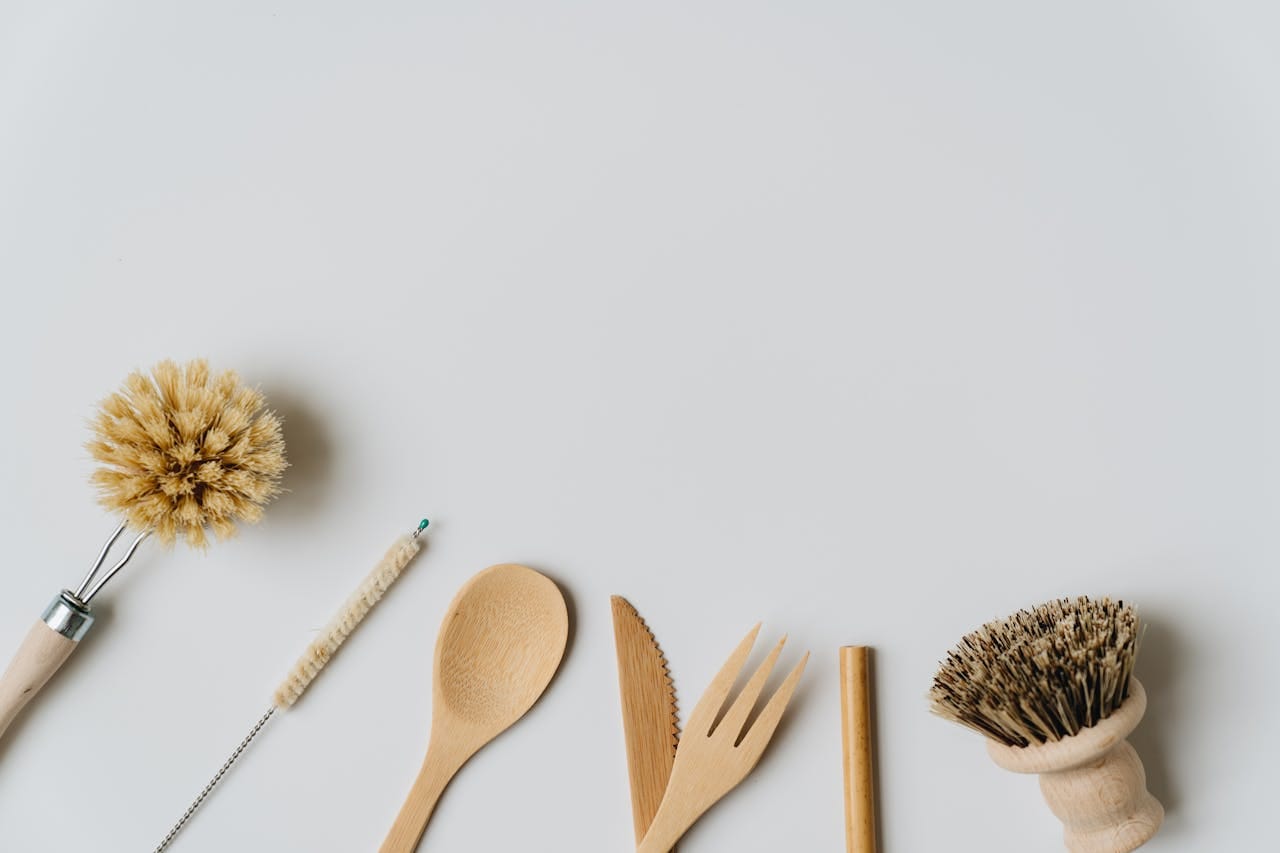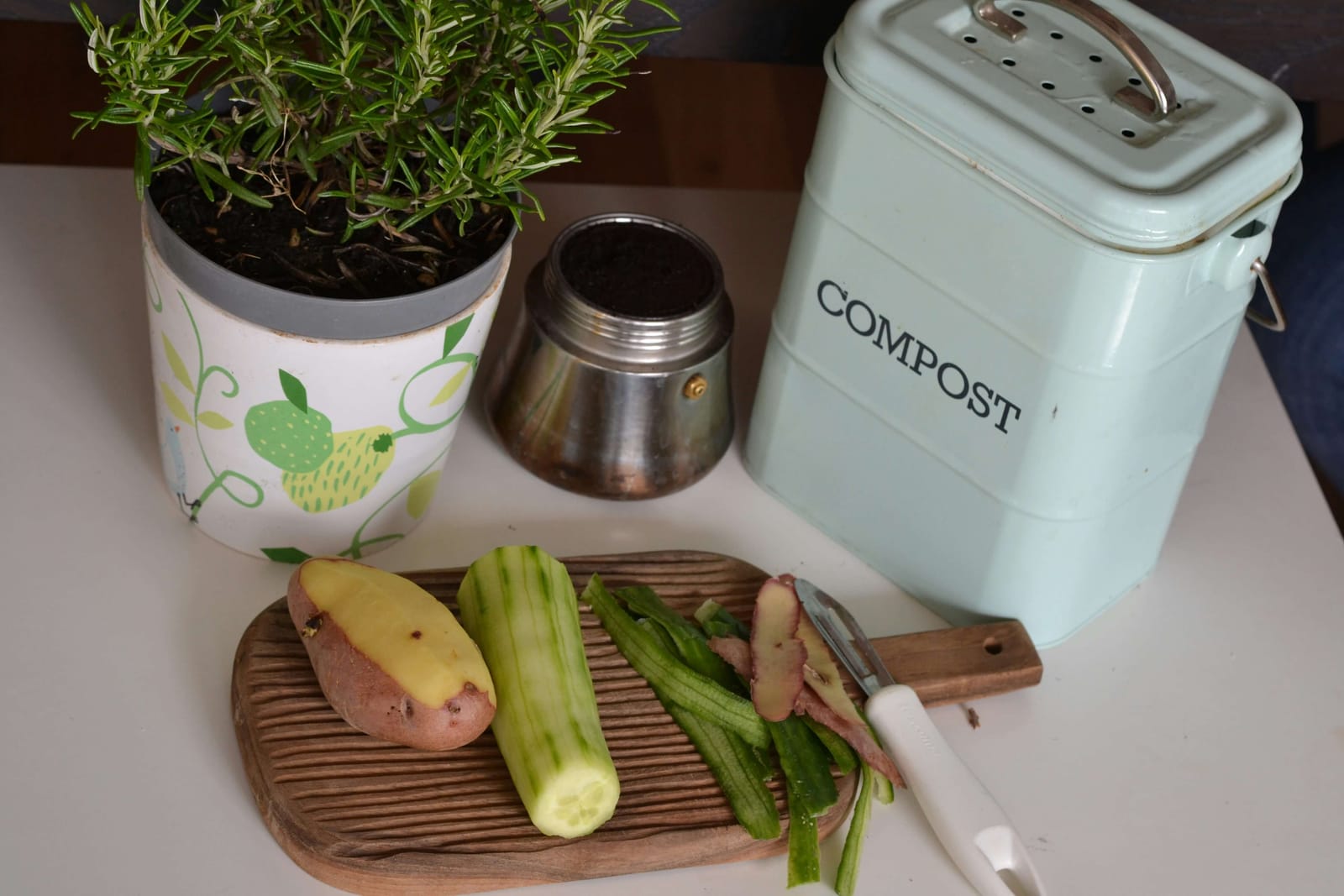Hey there! Ready to up your kitchen game with some of the best vegetable knives around? Imagine yourself in the kitchen, armed with the perfect blade – it slices through tomatoes effortlessly, dices onions like a pro, and makes chopping carrots feel like a breeze. It's all about finding that perfect knife, the one that feels just right in your hand and turns every meal prep into a fun adventure. Whether you're rustling up a quick snack or diving into a full-blown feast, we're here to guide you to the best knives out there. So, let's get ready to transform your kitchen experience with some seriously cool cutting companions!
🤝As an Amazon Associate, we earn from qualifying purchases made through our links, at ZERO additional cost to you.
5 Best Knives for Cutting Vegetables
- Best Overall: Mercer Millennia: Chef's Knife 8"
- Best for Precision Cutting & Slicing: Imarku: Santoku Knife 7"
- Best for Cutting Large Vegetables: Mercer Genesis: Nakiri 7"
- Best for Heavy-Duty Cutting Tasks: Zwilling: Chinese Vegetable Cleaver 7"
- Best for Detailed Kitchen Tasks: Henckels: Paring Knife 4"
1. Best Overall
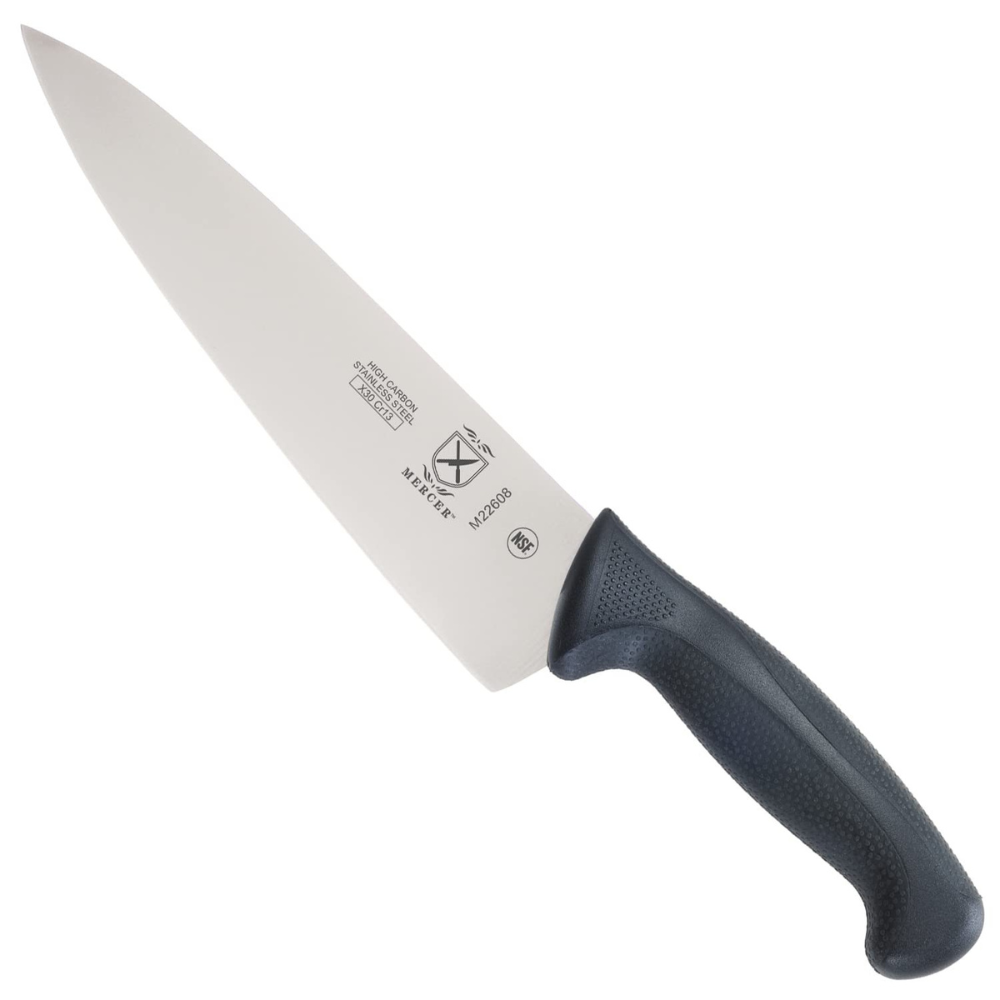
Mercer Millennia: Chef's Knife 8"
This knife's combination of quality construction, versatile use, ergonomic design, and affordability make it an excellent all-around choice for various kitchen tasks.
What We Love
- Quality Construction: Crafted from durable high-carbon Japanese steel.
- Ergonomic Design: Comfortable, non-slip handle for safe use.
- Versatile: Ideal for various cutting tasks in the kitchen.
- Easy Maintenance: Simple hand wash for lasting sharpness.
What to Keep in Mind
- Careful Cleaning: Requires hand washing for best upkeep.
Why It Might Be Right for You
Whether you're a seasoned chef or a home cook, the Mercer Millennia Chef's Knife is your go-to tool for a wide range of culinary tasks. Its versatility shines as you seamlessly transition from slicing meats to chopping vegetables. The comfort and balance it provides make every cut effortless, enhancing your overall cooking experience.
Customer Review (source: Amazon)
"Six Years and Still Sharp" - This knife is a fantastic investment, especially considering its affordable price. With proper use and periodic sharpening every few weeks, it has remained sharp even after six years of daily use.
2. Best for Precision Cutting and Slicing
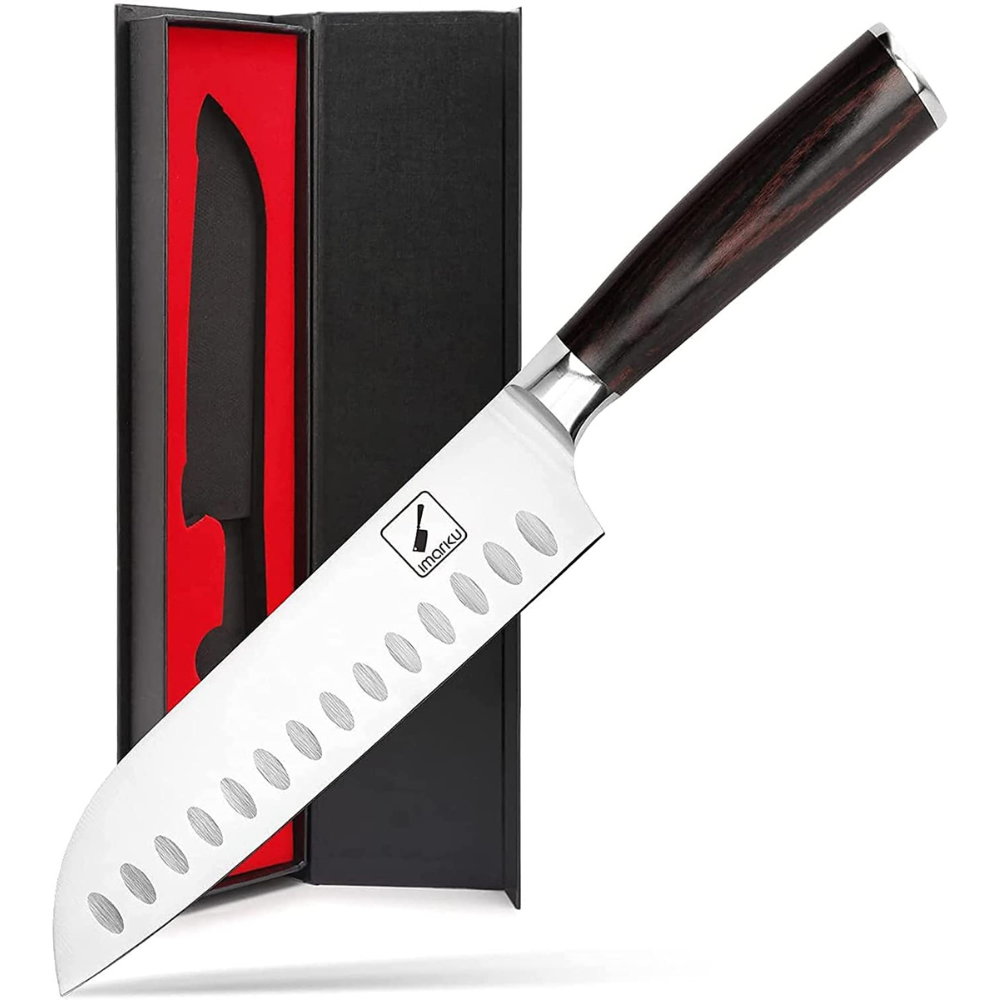
Imarku: Santoku Knife 7"
The ultra-sharp edge, hollow edge design, and ergonomic handle make this knife ideal for precise and delicate cutting tasks, such as slicing and dicing.
What We Love
- Professional Quality: Made of German HC stainless steel, ideal for various kitchen tasks.
- Ultra-Sharp Edge: Exceptionally sharp and sturdy with a 2.5mm blade thickness.
- Hollow Edge Design: Prevents sticking and adds stability during slicing.
- Ergonomic Handle: Advanced Pakkawood handle for comfort and minimal wrist tension.
What to Keep in Mind
- Blade Thickness: At 2.5mm, it may not be the best for extremely delicate slicing.
Why It Might Be Right for You
If your culinary passion lies in the art of perfect slicing and dicing, the Imarku Santoku Knife is your ideal companion. Its precision and ultra-sharp edge make it a dream for creating thin, uniform slices and finely diced ingredients. This knife brings a professional touch to your kitchen, elevating your dishes with its precision.
Customer Review (source: Amazon)
"Favorite Knife for All Purposes" - This knife has been purchased multiple times due to its quality and durability. Even after two years, it remains sharp, cutting through tough foods with ease. An excellent beginner knife and a versatile tool for all.
3. Best for Cutting Large Vegetables
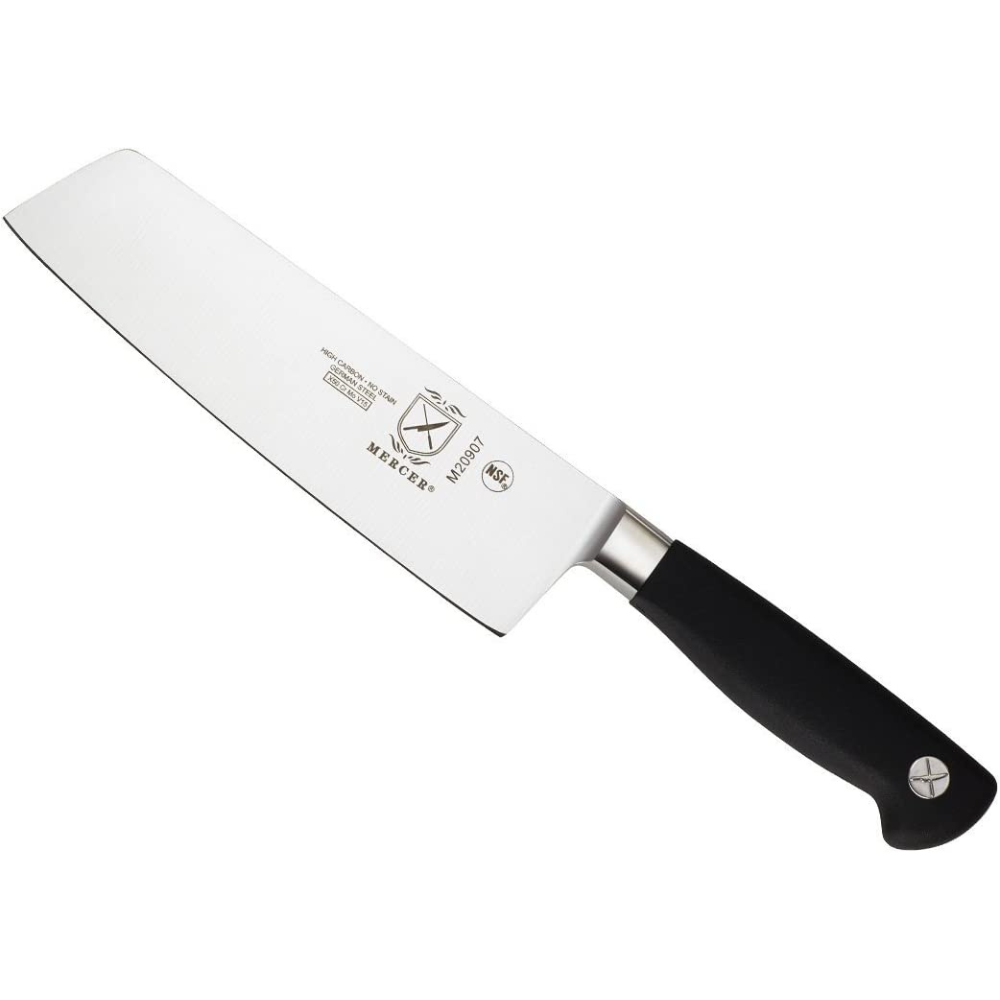
Mercer Genesis: Nakiri 7"
Its design and size are perfect for handling larger vegetables, offering efficient cutting with its quality construction and ergonomic handle.
What We Love
- Quality Construction: High-carbon German steel, precision-forged for durability and long-lasting sharpness.
- Ergonomic Design: Comfortable, non-slip handle, ideal even with wet hands.
- Versatile Use: Excellent for slicing and dicing meats, vegetables, fruits, and bread.
- Affordability: High quality at a very reasonable price.
What to Keep in Mind
- Size: Best suited for larger tasks, may not be ideal for smaller, delicate cuts.
Why It Might Be Right for You
For those who love preparing dishes with a variety of large vegetables, the Mercer Genesis Nakiri is a game-changer. Its design is tailored for easy chopping of bulky items like squash and cabbage, making quick work of what used to be challenging tasks. This knife turns the labor of vegetable prep into a joyful and efficient experience.
Customer Review (source: Amazon)
"High Quality, Great Price" - This solid knife performs perfectly, especially after an initial good sharpening. It's highly recommended for its quality and affordability.
4. Best for Heavy-Duty Cutting Tasks
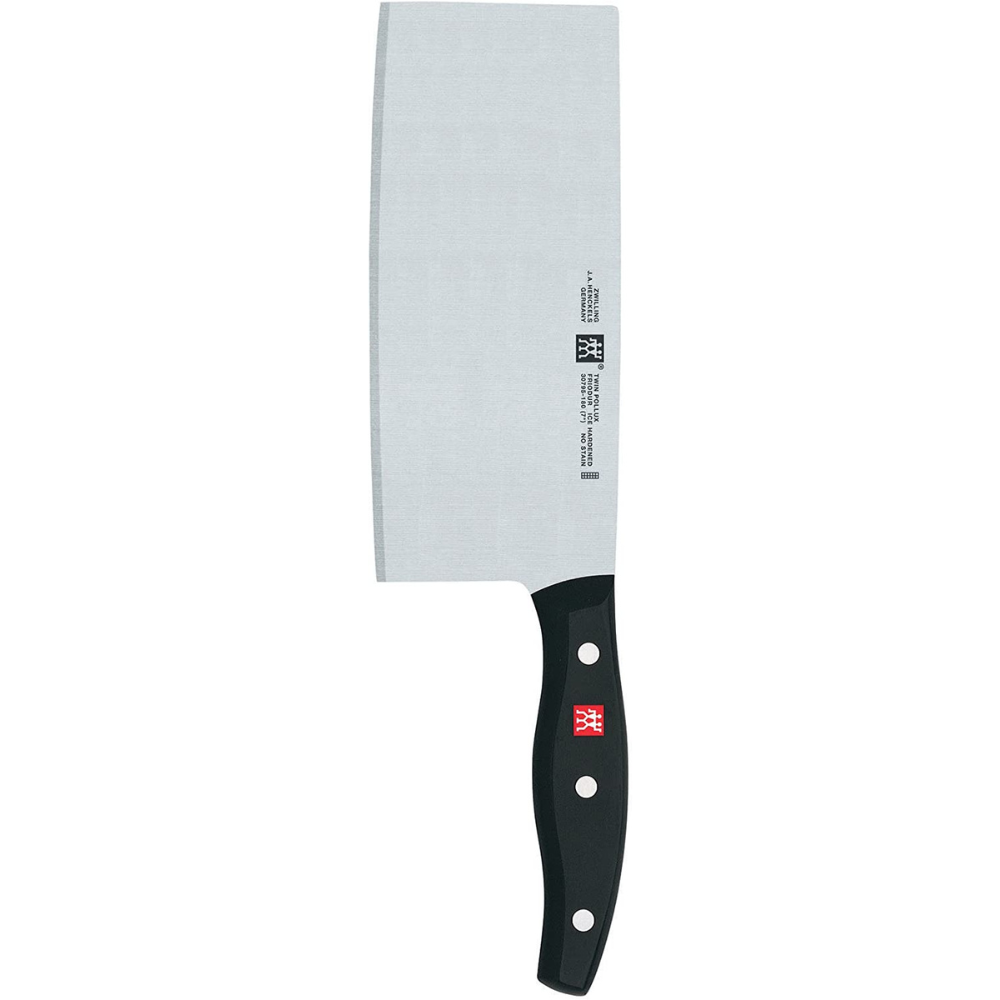
Zwilling: Chinese Vegetable Cleaver 7"
The robust construction, ultra-sharp edge, and larger size make this cleaver suitable for more demanding, heavy-duty tasks, especially involving larger vegetables and tougher cuts.
What We Love
- Ultra Razorsharp: Exceptional edge retention with 57 Rockwell Hardness.
- Quality Construction: Precision-forged from specially formulated German stainless steel.
- Ergonomic Design: Comfortable, non-slip handle, ideal for extended use.
- German Engineering: Crafted with nearly 300 years of expertise in Solingen, Germany.
What to Keep in Mind
- Care Instructions: Best maintained with hand washing and immediate drying. Avoid dishwasher use.
Why It Might Be Right for You
If your kitchen adventures often involve tackling tough, heavy-duty cutting tasks, the Zwilling Chinese Vegetable Cleaver will not disappoint. Its robust build and sharp edge power through thick vegetables and meats with ease. This cleaver is not just a knife; it's a statement of strength and efficiency in your culinary toolkit.
Customer Review (source: Amazon)
"Great Overall Knife" - This knife excels at cutting hard vegetables, with a sharp blade and a comfortable handle. It comes highly recommended.
5. Best for Detailed Kitchen Tasks
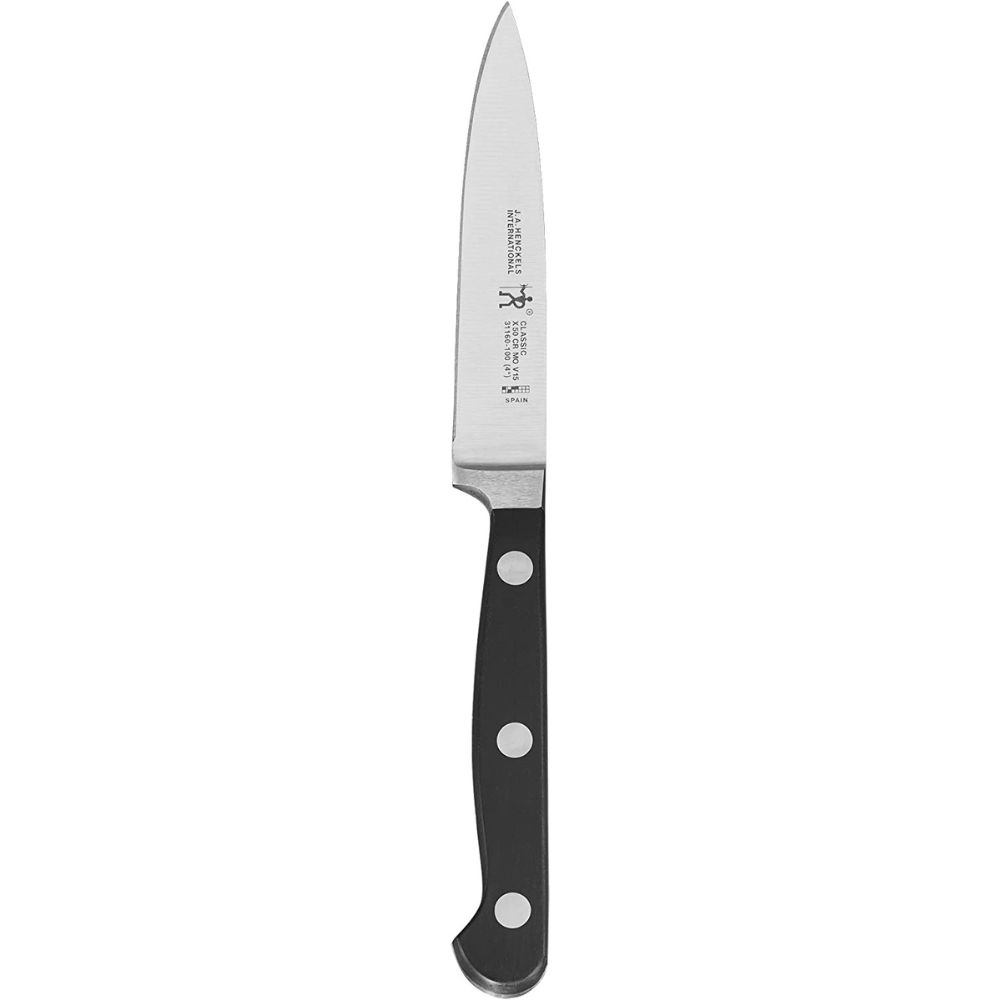
Henckels: Paring Knife 4"
The smaller size and ultra-sharp blade of this paring knife make it perfect for detailed and precise tasks, such as peeling and trimming fruits and vegetables.
What We Love
- Ultra-Sharp Blades: Professional-level sharpness for precision cutting.
- Long-Lasting Sharpness: Satin-finished blade stays sharp over time.
- Effortless Cutting: Lightweight and easy to handle for simple meal prep.
- Ideal for Detail: Perfect for prepping small fruits, vegetables, and meats.
- Easy Cleanup: Dishwasher safe, with stain and rust-resistant blades.
What to Keep in Mind
- Size: The 4" blade excels in detailed tasks but isn't meant for larger cuts.
Why It Might Be Right for You
When it comes to intricate kitchen tasks, the Henckels Paring Knife is unmatched. Its small size and sharp blade are perfect for the delicate work of peeling, trimming, and shaping fruits and vegetables. This knife brings precision and ease to the detailed aspects of cooking, making it a must-have for those who value finesse in their kitchen prep.
Customer Review (source: Amazon)
"Long-Lasting Quality" - These knives have proven to be reliable go-to tools for over 12 years. They stay sharp, resist rust, and are worth the investment. They are highly recommended.
How We Chose Our Top Picks
Our mission is to give you the inside scoop on these kitchen knives, even if we haven't personally tried each one. We've done our homework, digging deep into research and weighing what real users have to say. We've scoured through loads of customer reviews on Amazon, checking out what people love and what they don't. This helps us understand how these knives perform in real kitchens, how long they last, and how easy they are to use.
But we didn't stop there. We also lined these knives up against their rivals to see how they stack up. It's like a kitchen knife showdown! We looked at things like sharpness, how comfy they are to hold, and whether they're a breeze to clean. Our goal? To help you spot the perfect knife for your chopping, slicing, and dicing adventures. Whether you're a newbie in the kitchen or a pro chef, we've got the info you need to make a smart pick.
What Knife is Used for Cutting Vegetables?
When it comes to chopping veggies, the right knife can make all the difference. The most popular choice? The chef's knife. With its long, sharp blade, it's a real powerhouse for slicing through tough veggies like carrots and potatoes. The blade's curve lets you rock it back and forth, making chopping and slicing a breeze.
But don't forget about the bread knife! Its serrated edge isn't just for loaves of bread. It's fantastic for slicing softer fruits and veggies, like tomatoes and mushrooms, without squishing them. Plus, it's great for tackling the tough skins of fruits like melons.
For the smaller tasks, a paring knife is your best friend. Its petite blade is perfect for peeling, coring fruits, or even getting those tricky bits of meat off poultry bones.
Starting your kitchen knife collection? We suggest these three must-haves: a chef's knife, a paring knife, and a bread knife. They'll cover most of your kitchen needs, and you can always expand your collection as you get more comfortable with your chopping skills!
What should be the material of the knife?
There are many different materials that can be used for knives, but not all of them are equally well-suited for cutting vegetables. In general, the best knife for cutting vegetables is one that is made from high-carbon stainless steel. This type of steel is extremely hard and will stay sharp for a long time, making it ideal for repetitive cutting tasks.
Also, high-carbon stainless steel is resistant to corrosion, which is important when working with foods containing acids. Finally, this type of steel is also relatively easy to sharpen, so you can keep your knife in good condition even with frequent use. While other materials can be used for knives, high-carbon stainless steel is usually the best choice for cutting vegetables.
What are the five basic knife cuts?
There are many different knife cuts you can use to prepare food. The five basic knife cuts are:
Chop: This is the most basic knife cut and involves striking the tip of your knife on the board to cut through food. This is appropriate for large pieces of food that won't fit in a blender or food processor.
Dice: Dice is a very fine chop, perfect for small ingredients like garlic cloves or shallots. You'll need to have good knife skills to do this correctly, but it's great practice for more advanced cuts!
Mince: Mincing is a smaller version of dicing, and it's usually used for herbs or other small ingredients that need to be finely chopped up before cooking them into a dish—like when you're making a pesto sauce!
Slice: Slicing refers to cutting food with one long stroke of your knife through its center axis (perpendicular), like when you slice an onion in half from top to bottom or thinly slice cucumbers lengthwise, so they look like ribbons instead of coins.
Chiffonade: Chiffonade is French for 'rags,' which refers to how thin strips of leafy greens get when they're sliced lengthwise into thin ribbons
Frequently Asked Questions
Can I put my double-bevel vegetable knife in the dishwasher?
No, we do not recommend putting your vegetable knife in the dishwasher. The detergents and high temperatures can damage the blade and handle of your knife. Instead, wash your knife by hand using warm water and soap.
What are some tips for cutting vegetables safely?
Some important tips for cutting vegetables and thin slices safely include: using a cutting board, keeping careful track of where your fingers are relative to the blade, avoiding sudden movements, and making sure that blades are always pointed away from you when not in use.
What is the advantage of a curved cutting edge on a knife?
A curved cutting edge, like the one found on many chef's knives, allows for a rocking motion when cutting. This makes it easier to mince herbs and chop vegetables efficiently.
How does a flat paring knife differ from a sharp tipped one?
A flat paring knife, also known as a sheep's foot paring knife, has a straight edge and a rounded tip. It's great for precise slicing and dicing, but it may not be as versatile as a sharp tipped paring knife for tasks that require piercing.
What makes a Japanese style knife unique?
Japanese style knives, like the Santoku, often feature a flat cutting edge and a thinner blade than a Western chef's knife. This design allows for precise, clean cuts, making them ideal for tasks like slicing fish or chopping vegetables.
I'm looking to upgrade my kitchen tools. What should I consider when choosing a good vegetable knife?
When selecting a good vegetable knife, it's important to consider the type of vegetables you frequently prepare and the cuts you need to make. For most kitchen tasks, a utility knife is incredibly versatile. It's smaller than a chef's knife but larger than a paring knife, making it perfect for a variety of vegetables.
What knife is used for cutting vegetables?
A chef's knife or a vegetable knife (sometimes called a santoku knife) is commonly used for cutting vegetables. These knives offer a good balance, sharp edge, and versatility, making them ideal for chopping, dicing, and slicing a variety of vegetables.
How to use a knife for cutting vegetables?
- Prepare Your Workspace: Ensure you have a clean, stable cutting board and your vegetables are washed.
- Grip the Knife Properly: Hold the handle of the knife with your dominant hand, with your thumb and index finger gripping the sides of the blade base for control.
- Use a Claw Grip for Vegetables: Hold the vegetable with your non-dominant hand, curling your fingers inward like a claw to keep them away from the blade.
- Cutting Technique: Use a rocking motion to cut, keeping the tip of the knife on the cutting board and rocking the blade down through the vegetable. Adjust your technique based on the size and shape of the vegetable.
How to hold a knife when cutting vegetables?
- Proper Grip: Hold the knife by the handle with your dominant hand. Place your thumb on one side of the blade's base and your index finger on the opposite side, slightly curled, not extending along the top of the blade. This grip gives you more control and precision.
- Support With Non-Dominant Hand: Use your non-dominant hand to hold the vegetable. Curl your fingers inward to form a claw shape, allowing the side of the knife to gently guide against the knuckles of your hand. This helps in making precise cuts while keeping your fingers safe.
Items Reviewed
- Best Overall: Mercer Millennia: Chef's Knife 8"
- Best for Precision Cutting & Slicing: Imarku: Santoku Knife 7"
- Best for Cutting Large Vegetables: Mercer Genesis: Nakiri 7"
- Best for Heavy-Duty Cutting Tasks: Zwilling: Chinese Vegetable Cleaver 7"
- Best for Detailed Kitchen Tasks: Henckels: Paring Knife 4"

Best Overall: Mercer Millennia: Chef's Knife 8"
This knife's combination of quality construction, versatile use, ergonomic design, and affordability make it an excellent all-around choice for various kitchen tasks.
Further Reading
- A Micro-Guide to Different Types of Kitchen Knives: Explore the variety of kitchen knives and their specific uses in our micro-guide
- Essential Care for Your Vegetable Knives: Maintenance Tips & Techniques: Get practical advice on how to keep your vegetable knives in optimal condition.
- Design & Functionality: The Science of an Effective Vegetable Knife: Dive into the principles that make a vegetable knife effective in terms of design and functionality.
- 7 Tips for Knife Care And Maintaining Your Knife by KOI: Follow KOI's guide to extend your knife's lifespan with seven key maintenance tips.
- For insights into knife sharpening techniques, visit Mercer Culinary's website dedicated to Sharpening.
Please note that the reviews on this page have been edited for readability and clarity while maintaining the essence of the original content.

